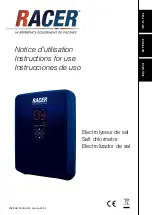
Page 44
LXi
™
Pool/Spa Heater Installation and Operation Manual
control provides a pre-purge of the combustion
chamber. Once the pre-purge is complete the
ignition control then applies electrical power to
a “hot surface” igniter. When the igniter is hot
enough, the ignition control opens the gas valve.
It has sophisticated means to sense ignition and
fl
ame condition so that unburned gas will not es-
cape. Once the ignition control has sensed
fl
ame,
it de-energizes the igniter. After the burner is shut
off, the ignition control continues blower opera-
tion to provide a post-purge period.
5.
Igniter -
The hot surface igniter is a crystalline
element which becomes very hot when electri-
cal power is applied to it. The hot surface igniter
directly ignites the air/gas mixture in the combus-
tion chamber.
6.
Limit Switches -
Two limit switches prevent
excessive water temperature - one at the heat
exchanger outlet and one for water leaving the
heater. If either senses excessive temperature,
burner operation is interrupted.
7.
Water Pressure Switch
- This control senses
whether or not water is available to the heater by
measuring back pressure inside of the heat ex-
changer. If the pool water pump fails or the water
fi
lter is blocked, the pressure switch prevents
operation of the burner.
8.
Fusible Link -
This is a single-use switch which
detects abnormal temperature in the component
compartment of the heater. It is a fusible link
which is held to the combustion chamber just
above the burner tray by a sheet metal bracket.
Excessive temperature in the component com-
partment, possibly due to a burner
fl
ash-back
will cause the link to fail. This opens the safety
circuit which shuts off the gas valve and shuts the
heater down.
9.
Air Pressure Switch -
This switch veri
fi
es that
air is
fl
owing through the combustion system
by sensing pressure. It shuts off the heater if air
fl
ow is inadequate.
10.
Flame Sensor -
The
fl
ame sensor is the electrode
through which the ignition control detects "rec-
ti
fi
cation" of current passed through the
fl
ame.
Inadequate recti
fi
cation indicates an unsatisfac-
tory
fl
ame condition. The recti
fi
cation signal
can be measured by attaching the leads of a DC
ammeter to the two pins on the connector of the
ignition control labeled "FC". A wire harness,
available from Jandy, makes it easier to attach the
voltmeter leads. The
fl
ame current should not be
less than 1.5 micro-amps. If the
fl
ame signal is
less than 1.5 micro-amps, verify correct gas sup-
ply and manifold pressures.
10.4 Special Service Issues - Premix
Combustion System
10.4.1 System Operation
Premix combustion systems are less tolerant of
fuel and air imbalance than other technologies. Fuel
gas properties, incorrect supply or manifold pressure
affect their operation and reliability. If fuel gas heat
content is low, combustion is "lean" and tends to be
unstable. Flames may lift off the burner, causing out-
age. If heat content is high, "rich" combustion results,
with low, hot
fl
ames that can overheat the burners.
Likewise, low gas supply or manifold pressure results
in lean, unstable combustion and high manifold pres-
sure results in a rich process and hot burners.
The air pressure inside the burner throat also
effects combustion. Incorrect air pressure will affect
performance and reliability of the heater. The burner
throat pressure should be adjusted to 1.0" W.C. (See
Section 10.4.3
for adjustment procedures.) If the air
pressure is too high, combustion will tend to be “lean”
and unstable. Flames may lift off the burners and be
extinguished. If air pressure is to low, the combus-
tion will be “rich”. The
fl
ames will be low and hot.
This could lead to burner overheating and failure. The
burner throat and gas manifold pressure need to be bal-
anced for stable combustion to occur.
The sealing of the combustion chamber and
fl
ue
assembly is also important to maintaining good com-
bustion. The combustion chamber of the LXi runs at a
slightly positive pressure (0.08" W.C. to 0.18" W.C.).
It is important that combustion products do not leak
from the combustion chamber or
fl
ue collector inside
the cabinet of the heater where they will be pulled into
the combustion air fan. Most of the oxygen in combus-
tion products has been consumed. If these combustion
products are pulled into the combustion air fan, it may
cause a rich combustion condition and that will lead to
a short yellow streaked
fl
ame that can decrease burner
life. Combustion chamber and
fl
ue collector sealing
must be maintained in “factory” condition. Service
operation involving burner, heat exchanger or fuel col-
lector removal must be conducted with this in mind.
10.4.2 Field Service and Adjustment
As with all gas-
fi
red appliances, the
fi
rst order of
business is to verify correct gas type, supply pressure,
manifold pressure, and burner throat pressure as speci-
fi
ed on the heater rating plate and in other sections of
this manual.
If the problems with lifting or short yellow/or-
ange
fl
ames cannot be corrected with the slight change
in manifold pressure and burner throat pressure, it is
likely that the fuel supply dffers greatly from average.
In this event, it may be necessary to replace the gas
ori
fi
ces. Contact the Jandy Technical Service Group at
1.707.776.8200, extension 260 for assistance.
Summary of Contents for LXi
Page 2: ......













































